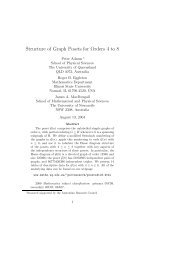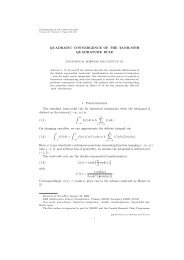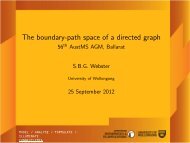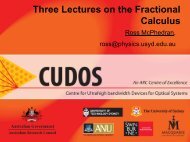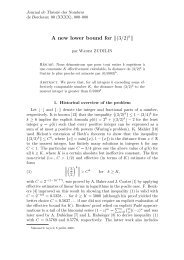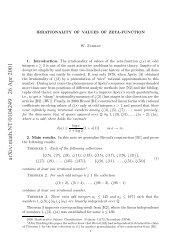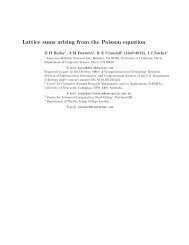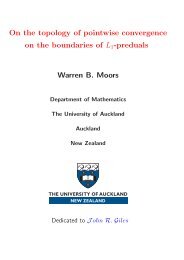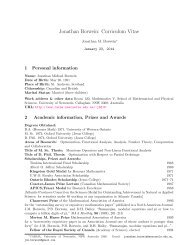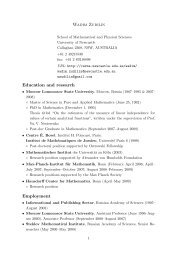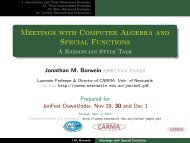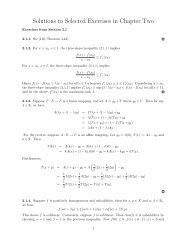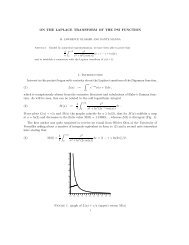The PSLQ Algorithm: Techniques for Efficient ... - David H Bailey
The PSLQ Algorithm: Techniques for Efficient ... - David H Bailey
The PSLQ Algorithm: Techniques for Efficient ... - David H Bailey
You also want an ePaper? Increase the reach of your titles
YUMPU automatically turns print PDFs into web optimized ePapers that Google loves.
<strong>The</strong> <strong>PSLQ</strong> <strong>Algorithm</strong>:<br />
<strong>Techniques</strong> <strong>for</strong> <strong>Efficient</strong> Computation<br />
<strong>David</strong> H <strong>Bailey</strong><br />
Lawrence Berkeley National Laboratory<br />
http://crd.lbl.gov/~dhbailey<br />
1
LBNL’s high-precision software<br />
QD: double-double (31 digits) and quad-double (62 digits).<br />
ARPREC: arbitrary precision.<br />
Low-level routines written in C++.<br />
C++ and Fortran-90 translation modules permit use with existing C++ and<br />
Fortran-90 programs -- only minor code changes are required.<br />
Includes many common functions: sqrt, cos, exp, gamma, etc.<br />
<strong>PSLQ</strong>, root finding, numerical integration.<br />
Available at: http://www.experimentalmath.info<br />
Authors: Xiaoye Li, Yozo Hida, Brandon Thompson and DHB.<br />
Currently being maintained with the able assistance of Alex Kaiser of LBNL.<br />
2
<strong>The</strong> <strong>PSLQ</strong> integer relation algorithm<br />
Let (x n ) be a given vector of real numbers. An integer relation algorithm<br />
finds integers (a n ) such that<br />
a 1 x 1 + a 2 x 2 + ···+ a n x n = 0<br />
(or within “epsilon” of zero, where epsilon = 10 -p and p is the precision).<br />
At the present time the “<strong>PSLQ</strong>” algorithm of mathematician-sculptor<br />
Helaman Ferguson is the most widely used integer relation algorithm. It<br />
was named one of ten “algorithms of the century” by Computing in Science<br />
and Engineering.<br />
1. H. R. P. Ferguson, DHB and S. Arno, “Analysis of <strong>PSLQ</strong>, an integer relation finding algorithm,”<br />
Mathematics of Computation, vol. 68, no. 225 (Jan 1999), pg. 351-369.<br />
2. DHB and D. J. Broadhurst, “Parallel integer relation detection: <strong>Techniques</strong> and applications,” Mathematics<br />
of Computation, vol. 70, no. 236 (Oct 2000), pg. 1719-1736.<br />
3
<strong>PSLQ</strong>, continued<br />
<strong>PSLQ</strong> constructs a sequence of integer-valued matrices B n that reduces<br />
the vector y = x B n , until either the relation is found (as one of the columns<br />
of B n ), or else precision is exhausted.<br />
At the same time, <strong>PSLQ</strong> generates a steadily growing bound on the size<br />
of any possible relation.<br />
When a relation is found, the size of smallest entry of the vector y abruptly<br />
drops to roughly “epsilon” (i.e. 10 -p , where p is the number of digits of<br />
precision).<br />
<strong>The</strong> size of this drop can be viewed as a “confidence level” that the<br />
relation is real and not merely a numerical artifact -- a drop of 20+ orders<br />
of magnitude almost always indicates a real relation.<br />
<strong>PSLQ</strong> (or any other integer relation scheme) requires very high precision<br />
arithmetic (at least nd digits, where d is the size in digits of the largest a k ),<br />
both in the input data and in the operation of the algorithm.<br />
4
Decrease of log 10 (min k |y k |) as a function<br />
of iteration number in a typical <strong>PSLQ</strong> run<br />
5
Methodology <strong>for</strong> using <strong>PSLQ</strong> to<br />
recognize an unknown constant α <br />
Calculate α to high precision – typically 100 - 1000 digits. This is often the<br />
most computationally expensive part of the entire process.<br />
Based on experience with similar constants or relations, make a list of<br />
possible terms on the right-hand side (RHS) of a linear <strong>for</strong>mula <strong>for</strong> α, then<br />
calculate each of the n RHS terms to the same precision as α.<br />
If you suspect α is algebraic of degree n (the root of a degree-n polynomial<br />
with integer coefficients), compute the vector (1, α, α 2 , α 3 , …, α n ).<br />
Apply <strong>PSLQ</strong> to the (n+1)-long vector, using the same numeric precision as<br />
α, but with a detection threshold a few orders of magnitude larger than<br />
“epsilon”– e.g., 10 -480 instead of 10 -500 <strong>for</strong> 500-digit arithmetic.<br />
When <strong>PSLQ</strong> runs, look <strong>for</strong> a detection following a drop in the size of the<br />
reduced y vector by at least 20 orders of magnitude, to value near epsilon.<br />
If no credible relation is found, try expanding the list of RHS terms.<br />
Another possibility is to search <strong>for</strong> multiplicative relations (i.e., monomial<br />
expressions), which can be done by taking logarithms of α and constants.<br />
6
Bifurcation points in chaos theory:<br />
<strong>The</strong> first “real” application of <strong>PSLQ</strong><br />
Let t = B 3 = the smallest r such<br />
that the “logistic iteration”<br />
x n+1 = rx n (1 − x n )<br />
exhibits 8-way periodicity instead<br />
of 4-way periodicity.<br />
By means of a sequential<br />
approximation scheme, one can<br />
obtain the numerical value of t to<br />
any desired precision:<br />
3.544090359551922853615965986604804540583099845444573675457812<br />
5303058429428588630122562585664248917999626…<br />
Applying <strong>PSLQ</strong> to (1, t, t 2 , t 3 , …, t 12 ), we obtained the result that t is a root of:<br />
0 = 4913 + 2108t 2 − 604t 3 − 977t 4 +8t 5 + 44t 6 + 392t 7<br />
−193t 8 − 40t 9 + 48t 10 − 12t 11 + t 12<br />
7
Ising integrals<br />
We recently applied our methods to study three classes of integrals that<br />
arise in the Ising theory of mathematical physics – D n and two others:<br />
C n := 4 n!<br />
D n := 4 n!<br />
E n = 2<br />
∞<br />
0<br />
∞<br />
0<br />
1<br />
0<br />
···<br />
···<br />
···<br />
1<br />
∞<br />
where in the last line u k = t 1 t 2 … t k .<br />
0<br />
0<br />
∞<br />
0<br />
⎛<br />
⎝<br />
1 du 1<br />
n<br />
2<br />
j=1 (u u<br />
j +1/u j ) 1<br />
2 ui −u j<br />
i
Ising integral evaluations<br />
D 2 = 1/3<br />
D 3 = 8+4π 2 /3 − 27 L −3 (2)<br />
D 4 = 4π 2 /9 − 1/6 − 7ζ(3)/2<br />
E 2 = 6− 8 log 2<br />
E 3 = 10 − 2π 2 − 8 log 2 + 32 log 2 2<br />
E 4 = 22 − 82ζ(3) − 24 log 2 + 176 log 2 2 − 256(log 3 2)/3<br />
+16π 2 log 2 − 22π 2 /3<br />
E 5<br />
?<br />
= 42 − 1984 Li4 (1/2) + 189π 4 /10 − 74ζ(3) − 1272ζ(3) log 2<br />
+40π 2 log 2 2 − 62π 2 /3 + 40(π 2 log 2)/3 + 88 log 4 2<br />
+464 log 2 2 − 40 log 2<br />
where Li n (x) is the polylog function. D 2 , D 3 and D 4 were originally provided<br />
to us by mathematical physicist Craig Tracy, who hoped that our tools could<br />
help identify D 5 .<br />
9
Recursions in Ising integrals<br />
Consider the 2-parameter class of Ising integrals (which arises in QFT <strong>for</strong> odd k):<br />
C n,k = 4 n!<br />
∞<br />
After computing 1000-digit numerical values <strong>for</strong> all n up to 36 and all k up to 75<br />
(per<strong>for</strong>med on a highly parallel computer system), we discovered (using <strong>PSLQ</strong>)<br />
linear relations in the rows of this array. For example, when n = 3:<br />
0 = C 3,0 − 84C 3,2 + 216C 3,4<br />
0 = 2C 3,1 − 69C 3,3 + 135C 3,5<br />
0 = C 3,2 − 24C 3,4 + 40C 3,6<br />
0<br />
···<br />
∞<br />
0 = 32C 3,3 − 630C 3,5 + 945C 3,7<br />
0 = 125C 3,4 − 2172C 3,6 + 3024C 3,8<br />
0<br />
1<br />
du 1<br />
n<br />
k+1<br />
j=1 (u u<br />
j +1/u j ) 1<br />
Similar, but more complicated, recursions have been found <strong>for</strong> all n.<br />
DHB, D. Borwein, J.M. Borwein and R.E. Crandall, “Hypergeometric <strong>for</strong>ms <strong>for</strong> Ising-class integrals,”<br />
Experimental Mathematics, vol. 16 (2007), pg. 257-276.<br />
J. M. Borwein and B. Salvy, “A proof of a recursion <strong>for</strong> Bessel moments,” Experimental Mathematics, vol. 17<br />
(2008), pg. 223-230.<br />
10<br />
···du n<br />
u n
Recent result (18 Jan 2009)<br />
∆ 3 (−1) =<br />
= 1<br />
15<br />
<br />
2 ∞<br />
√ π<br />
0<br />
(−1+e −u2 + √ π u erf(u)) 3<br />
u 6<br />
<br />
6+6 √ 2 − 12 √ 3 − 10π + 30 log(1 + √ 2) + 30 log(2 + √ <br />
3)<br />
du<br />
As in many of the previous results, this was found by first computing the<br />
integral to high precision (250 to 1000 digits), conjecturing possible terms<br />
on the right-hand side, then applying <strong>PSLQ</strong> to look <strong>for</strong> a relation. We now<br />
have proven this result.<br />
Dozens of similar results have since been found (see next few viewgraphs),<br />
raising hope that all box integrals eventually will be evaluated in closed<br />
<strong>for</strong>m.<br />
DHB, J. M. Borwein and R. E. Crandall, “Advances in the theory of box integrals,” manuscript, Mar 2009,<br />
available at http://crd.lbl.gov/~dhbailey/dhbpapers/BoxII.pdf.<br />
11
Recent evaluations of box integrals<br />
n s B n (s)<br />
any even s ≥ 0 rational, e.g., : B 2 (2) = 2/3<br />
1<br />
1 s = −1<br />
s+1<br />
2 -4 − 1 4 − π 8<br />
2 -3 − √ 2<br />
2 -1 2 log(1 + √ √<br />
2)<br />
1<br />
2 1<br />
3 2+<br />
1<br />
√<br />
2)<br />
7<br />
2 3<br />
5 2+<br />
3<br />
20 log(1 + √ 2)<br />
2<br />
2 s = −2<br />
2+s 2 F 1 1 2 , − s 2 ; 3 2 ; −1<br />
3 -5 − 6√ 1 3 −<br />
1<br />
12 π<br />
3 -4 − 2√ 3 2 arctan √2 1<br />
3 -2 −3G + 3 2 π log(1 + √ 2) + 3 Ti 2 (3 − 2 √ 2)<br />
3 -1 − 1 4 π + 3 2 log 2+ √ 3 <br />
√<br />
1<br />
3 1<br />
4 3 −<br />
1<br />
24 π + 1 2 log 2+ √ 3 <br />
√<br />
2<br />
3 3<br />
5 3 −<br />
1<br />
60 π − 7<br />
20 log 2+ √ 3 <br />
Here F is hypergeometric function; G is Catalan; Ti is Lewin’s inverse-tan function.<br />
12
Elliptic Integrals<br />
Recent research in integrals of elliptic functions have revealed hundreds of<br />
hereto<strong>for</strong>e unknown identities, <strong>for</strong> instance:<br />
2<br />
1<br />
0<br />
K 2 (x)dx − 4<br />
1<br />
0<br />
−2<br />
K(x)E(x)dx +3<br />
1<br />
0<br />
−2<br />
1<br />
1<br />
K 3 (x)K (x)E (x)dx +<br />
0<br />
0<br />
xK(x)dx +3<br />
E 2 (x)dx −<br />
1<br />
0<br />
1<br />
0<br />
1<br />
0<br />
xE(x)dx = 0<br />
K (x)E (x)dx = 0<br />
E(x)K 3 (x)E (x)dx = 0<br />
<strong>The</strong>se studies involved computing thousands of individual definite<br />
integrals, each to at least 1600-digit precision, then searching <strong>for</strong><br />
relations among them using <strong>PSLQ</strong>.<br />
13
Statement of the <strong>PSLQ</strong> algorithm<br />
Initialization:<br />
1. For j := 1 to n: <strong>for</strong> i := 1 to n: if i = j then set A ij := 1 and B ij := 1<br />
else set A ij := 0 and B ij := 0; end<strong>for</strong>; end<strong>for</strong>.<br />
2. For k := 1 to n: sets k :=<br />
n<br />
j=k x2 j ; end<strong>for</strong>. Set t =1/s 1. For k := 1 to<br />
n: sety k := tx k ; s k := ts k ; end<strong>for</strong>.<br />
3. Initial H: For j := 1 to n − 1: <strong>for</strong> i := 1 to j − 1: set H ij := 0; end<strong>for</strong>;<br />
set H jj := s j+1 /s j ; <strong>for</strong> i := j +1 to n: setH ij := −y i y j /(s j s j+1 ); end<strong>for</strong>;<br />
end<strong>for</strong>.<br />
4. Reduce H: For i := 2 to n: <strong>for</strong> j := i − 1 to 1 step −1: set t :=<br />
nint(H ij /H jj ); and y j := y j + ty i ; <strong>for</strong> k := 1 to j: setH ik := H ik − tH jk ;<br />
end<strong>for</strong>; <strong>for</strong> k := 1 to n: set A ik := A ik − tA jk and B kj := B kj + tB ki ;<br />
end<strong>for</strong>; end<strong>for</strong>; end<strong>for</strong>.<br />
14
Statement of the <strong>PSLQ</strong> algorithm,<br />
continued<br />
Iteration:<br />
1. Select m such that γ i |H ii | is maximal when i = m.<br />
2. Exchange the entries of y indexed m and m + 1, the corresponding rows<br />
of A and H, and the corresponding columns of B.<br />
<br />
3. Remove corner on H diagonal: If m ≤ n−2 then set t 0 := Hmm 2 + Hm,m+1 2 ,<br />
t 1 := H mm /t 0 and t 2 := H m,m+1 /t 0 ; <strong>for</strong> i := m to n: set t 3 := H im ,<br />
t 4 := H i,m+1 , H im := t 1 t 3 + t 2 t 4 and H i,m+1 := −t 2 t 3 + t 1 t 4 ; end<strong>for</strong>;<br />
endif.<br />
4. Reduce H: For i := m +1 to n: <strong>for</strong> j := min(i − 1,m+ 1) to 1 step<br />
−1: set t := nint(H ij /H jj ) and y j := y j + ty i ; <strong>for</strong> k := 1 to j: set<br />
H ik := H ik − tH jk ; end<strong>for</strong>; <strong>for</strong> k := 1 to n: set A ik := A ik − tA jk and<br />
B kj := B kj + tB ki ; end<strong>for</strong>; end<strong>for</strong>; end<strong>for</strong>.<br />
5. Norm bound: Compute M := 1/ max j |H jj |. <strong>The</strong>n there can exist no<br />
relation vector whose Euclidean norm is less than M.<br />
6. Termination test: If the largest entry of A exceeds the level of numeric<br />
precision used, then precision is exhausted. If the smallest entry of the y<br />
vector is less than the detection threshold (see below), a relation has been<br />
detected and is given in the corresponding column of B.<br />
15
Multi-level implementations of <strong>PSLQ</strong><br />
In spite of the effectiveness of <strong>PSLQ</strong>, computation time grows cubically<br />
with the vector size n and also increases sharply with the level of<br />
numerical precision employed.<br />
Huge savings in run time can be achieved by employing a “two-level”<br />
implementation of <strong>PSLQ</strong>: Per<strong>for</strong>m most iterations with simple doubleprecision<br />
arithmetic, periodically updating the multiprecision arrays.<br />
Because double-precision arithmetic is so much faster, savings of up to<br />
100X can be achieved.<br />
For very large n and very high precision, additional savings can be<br />
achieved by employing a “three-level” scheme: double precision,<br />
“intermediate precision” (typically 120 digits), and full multiprecision.<br />
16
Details of two-level <strong>PSLQ</strong><br />
1. Per<strong>for</strong>m standard <strong>PSLQ</strong> initialization.<br />
2. Per<strong>for</strong>m DP “re-initialization”: set A and B = I, y = y (scaled so max =<br />
1.0), and H = H (here underscore denotes DP approximations).<br />
3. Per<strong>for</strong>m LQ matrix factorization of H, and replace H with lower-diagonal.<br />
4. Per<strong>for</strong>m <strong>PSLQ</strong> iterations using DP arrays. When the largest entry of A<br />
and B exceeds 10 13 , or if a very small entry is detected in the y vector,<br />
update full-precision y, A, B, H arrays by matrix multiplication.<br />
5. Check full-precision y vector <strong>for</strong> an entry that is zero (or smaller than<br />
some acceptable epsilon). If so, a relation has been detected.<br />
6. Compute norm bound.<br />
7. Repeat beginning with step 2.<br />
Notes:<br />
<br />
<br />
Computation of full-precision A matrix may be omitted.<br />
Full-precision H matrix will not be in lower-triangular <strong>for</strong>m, and thus<br />
cannot be used to compute norm bounds, but H can be used <strong>for</strong> this.<br />
17
Some potential difficulties<br />
Occasionally a very large entry (> 2 53 = 9 x 10 15 approx.) is produced in<br />
the double precision A or B matrix, in spite of the 10 13 cutoff.<br />
One must also check if any intermediate value produced in the<br />
computation of any entry of A or B exceeds 2 53 .<br />
When this happens, it is necessary to:<br />
1. Abandon the current set of DP iterations.<br />
2. Retreat to stored values of y, A, B and H at some previous iteration.<br />
3. Update the multiprecision arrays using these stored values.<br />
4. Per<strong>for</strong>m a full LQ matrix factorization on H.<br />
5. Per<strong>for</strong>m multiprecision iterations, checking periodically (typically every ten<br />
iterations) to see if the dynamic range of the y vector has reduced to the<br />
point that DP iterations are safe again.<br />
A three-level implementation saves time on very large problems above a<br />
two-level scheme, mostly because intermediate precision can be used to<br />
handle these special cases instead of full precision.<br />
18
Per<strong>for</strong>mance results <strong>for</strong> 1-2-3 level <strong>PSLQ</strong>:<br />
Recover polynomial <strong>for</strong> alpha = 3^1/r – 2^1/s<br />
One-level Two-level Three-level<br />
r, s n Iterations Digits Time Digits Time Digits Time<br />
5,5 26 5143 180 32.37 190 1.29<br />
5,6 31 9357 240 105.48 250 3.16<br />
6,6 37 15217 310 298.85 320 7.19<br />
6,7 43 25361 420 942.66 420 17.22<br />
7,7 50 36947 500 2363.71 510 36.29<br />
7,8 57 60817 680 90.08<br />
8,8 65 86684 850 195.19 910 233.48<br />
8,9 73 124521 1050 425.67 1120 460.34<br />
9,9 82 174140 1310 934.96 1370 922.90<br />
9,10 91 245443 1620 2032.69 1680 1780.65<br />
10,10 101 342931 2000 4968.64 2060 3366.92<br />
19
<strong>The</strong> “multi-pair” <strong>PSLQ</strong> algorithm<br />
<strong>The</strong> standard <strong>PSLQ</strong> algorithm (even the basic one-level scheme) is poorly<br />
suited to parallel processing, because of recursions in the inner loop of<br />
the reduction step.<br />
In attempt to devise a scheme better suited <strong>for</strong> parallel processing, DHB<br />
developed the “multi-pair” <strong>PSLQ</strong> algorithm.<br />
<strong>The</strong> multi-pair <strong>PSLQ</strong> algorithm selects certain adjacent pairs of indices<br />
that can be reduced in one step, independently of the other pairs, thus<br />
providing an opportunity <strong>for</strong> parallel processing.<br />
As it turns out, the multi-pair <strong>PSLQ</strong> algorithm runs faster even on a single<br />
processor.<br />
Two-level and three-level multi-pair <strong>PSLQ</strong> schemes have been devised.<br />
Parallel versions of these have also been devised, albeit it with great<br />
difficulty.<br />
DHB has used “multi-pair” <strong>PSLQ</strong> (mostly 1- and 2-level) exclusively in<br />
recent research work.<br />
20
Statement of the multi-pair <strong>PSLQ</strong><br />
algorithm<br />
Initialize:<br />
1. For j := 1 to n: <strong>for</strong> i := 1 to n: if i = j then set A ij := 1 and B ij := 1<br />
else set A ij := 0 and B ij := 0; end<strong>for</strong>; end<strong>for</strong>.<br />
2. For k := 1 to n: sets k :=<br />
n<br />
j=k x2 j ; end<strong>for</strong>; set t =1/s 1; <strong>for</strong> k := 1 to<br />
n: sety k := tx k ; s k := ts k ; end<strong>for</strong>.<br />
3. Initial H: For j := 1 to n − 1: <strong>for</strong> i := 1 to j − 1: set H ij := 0; end<strong>for</strong>;<br />
set H jj := s j+1 /s j ; <strong>for</strong> i := j +1 to n: setH ij := −y i y j /(s j s j+1 ); end<strong>for</strong>;<br />
end<strong>for</strong>.<br />
21
Iterate.<br />
Statement of the multi-pair <strong>PSLQ</strong><br />
algorithm, continued<br />
1. Sort the entries of the (n − 1)-long vector {γ i |H ii |} in decreasing order,<br />
producing the sort indices.<br />
2. Beginning at the sort index m 1 corresponding to the largest γ i |H ii |,select<br />
pairs of indices (m i ,m i + 1), where m i is the sort index. If at any step<br />
either m i or m i + 1 has already been selected, pass to the next index in<br />
the list. Continue until either βn pairs have been selected, or the list<br />
is exhausted. Let p denote the number of pairs actually selected in this<br />
manner.<br />
3. For i := 1 to p, exchange the entries of y indexed m i and m i + 1, and the<br />
corresponding rows of A, B and H; end<strong>for</strong>.<br />
4. Remove corners on H diagonal: For i := 1 to p: if m i ≤ n − 2 then set<br />
t 0 := Hm 2 i ,m i<br />
+ Hm 2 i ,m i +1 , t 1 := H mi ,m i<br />
/t 0 and t 2 := H mi ,m i +1/t 0 ; <strong>for</strong><br />
i := m i to n: set t 3 := H i,mi ; t 4 := H i,mi +1; H i,mi<br />
H i,mi +1 := −t 2 t 3 + t 1 t 4 ; end<strong>for</strong>; endif; end<strong>for</strong>.<br />
22<br />
:= t 1 t 3 + t 2 t 4 ; and
Statement of the multi-pair <strong>PSLQ</strong>,<br />
continued<br />
6. Reduce H: For i := 2 to n: <strong>for</strong> j := 1 to n − i + 1: set l := i + j − 1; <strong>for</strong><br />
k := j+1 to l−1: set H lj := H lj −T lk H kj ; end<strong>for</strong>; set T lj := nint(H lj /H jj )<br />
and H lj := H lj − T lj H jj ; end<strong>for</strong>; end<strong>for</strong>.<br />
7. Update y: For j := 1 to n − 1: <strong>for</strong> i := j +1 ton: set y j := y j + T ij y i ;<br />
end<strong>for</strong>; end<strong>for</strong>.<br />
8. Update A and B: For k := 1 to n: <strong>for</strong> j := 1 to n − 1: <strong>for</strong> i := j +1ton:<br />
set A ik := A ik − T ij A jk and B jk := B jk + T ij B ik ; end<strong>for</strong>; end<strong>for</strong>; end<strong>for</strong>.<br />
9. Norm bound: Compute M := 1/ max j |H jj |. <strong>The</strong>n there can exist no<br />
relation vector whose Euclidean norm is less than M.<br />
10. Termination test: If the largest entry of A exceeds the level of numeric<br />
precision used, then precision is exhausted. If the smallest entry of the y<br />
vector is less than the detection threshold (see section 2), a relation has<br />
been detected and is given in the corresponding row of B.<br />
23
Per<strong>for</strong>mance results <strong>for</strong> multi-pair <strong>PSLQ</strong>:<br />
Recover polynomial <strong>for</strong> alpha = 3^1/r – 2^1/s<br />
One-level Two-level Three-level<br />
r, s n Iterations Digits Time Digits Time Digits Time<br />
5,5 26 558 180 26.08 180 1.48<br />
5,6 31 840 230 70.71 240 3.43<br />
6,6 37 1136 310 189.27 310 7.84<br />
6,7 43 1625 400 479.07 410 17.22<br />
7,7 50 2071 500 1130.85 500 35.64<br />
7,8 57 2410 660 69.39<br />
8,8 65 3723 800 169.62 880 214.66<br />
8,9 73 4943 1010 358.07 1100 427.29<br />
9,9 82 6169 1260 744.20 1320 804.51<br />
9,10 91 7850 1560 1556.37 1600 1450.29<br />
10,10 101 10017 1890 3283.08 1950 2747.12<br />
24
Large test problems<br />
1. “Fibonacci”:<br />
Studies a conjecture of Broadhurst on the dimension of certain Euler sums.<br />
n = 145.<br />
5,000 digits.<br />
2. “Bifurcation”:<br />
Finds the polynomial satisfies by the 8-16 bifurcation in the logistic iteration.<br />
n = 120.<br />
10,000 digits.<br />
3. “S(20)”:<br />
Finds an analytic evaluation of certain constants involving Clausen values.<br />
n = 118.<br />
5,000 digits.<br />
4. “Ladder”:<br />
Finds a relation among constants associated with a root of Lehmer’s poly.<br />
n = 125.<br />
50,000 digits.<br />
25
Parallel results on three test problems<br />
Fibonacci B 4 S(20)<br />
Processors Time Speedup Time Speedup Time Speedup<br />
1 47788 1.00 90855 1.00 23208 1.00<br />
2 24665 1.94 46134 1.97 11973 1.94<br />
4 12945 3.69 23966 3.79 6305 3.68<br />
8 7076 6.75 12924 7.03 3470 6.69<br />
16 4180 11.43 7424 12.24 2126 10.92<br />
32 2994 15.96 4865 18.68 1548 14.99<br />
48 2463 19.40 4049 22.44 1303 17.81<br />
26
Work to be done<br />
<strong>The</strong>se results are nearly 10 years old, employed an old all-Fortran<br />
multiprecision library and the OpenMP parallel model.<br />
<strong>The</strong> ARPREC package does not lend itself to OpenMP parallelization –<br />
each individual “thread” requires too much context.<br />
<strong>The</strong> MPI model can be used, but only <strong>for</strong> very large problems, because of<br />
greater data transfer overhead.<br />
<strong>The</strong> most likely parallel target <strong>for</strong> a parallel implementation is a sharedmemory,<br />
multicore system (such as recent Apple workstations).<br />
<strong>The</strong> UPC and Co-Array Fortran are more appropriate <strong>for</strong> such an<br />
environment.<br />
27
Work to be done, continued<br />
In addition, perhaps the whole approach to high-precision computation <strong>for</strong><br />
experimental math applications needs to be re-thought:<br />
One of the key developers of the QD and ARPREC libraries, is no longer<br />
interesting in doing development or maintenance.<br />
Recent progress by the GMP and MPFR packages show good promise –<br />
they out-per<strong>for</strong>ms ARPREC in certain precision levels, particularly above<br />
1000 digits.<br />
<strong>The</strong> ARPREC high-level C++ and Fortran-90 translation modules<br />
continue to be very effective (high-level modules <strong>for</strong> GMP<br />
Can we “marry” the high-level ARPREC modules with the low-level GMP<br />
modules?<br />
Outside the box:<br />
Are there other, completely novel programming environments that we<br />
should consider <strong>for</strong> this type of computation?<br />
Can we devise <strong>PSLQ</strong>-like algorithms <strong>for</strong> more general spaces?<br />
28
Summary<br />
<strong>The</strong> emerging “experimental” methodology in mathematics and<br />
mathematical physics often requires hundreds or even thousands of<br />
digits of precision.<br />
High-precision evaluation of integrals, followed by constant-recognition<br />
techniques, has been a particularly fruitful area of recent research, with<br />
many new results in pure math and mathematical physics.<br />
<strong>The</strong> <strong>PSLQ</strong> algorithm continues to be extremely effective in identifying<br />
constants and in finding relationships between constants.<br />
Multi-level and multi-pair variants of <strong>PSLQ</strong> are much faster and more<br />
effective than standard <strong>PSLQ</strong>.<br />
Much work needs to be done in developing new, parallel <strong>PSLQ</strong> software,<br />
and in improving multiprecision software in general.<br />
29



